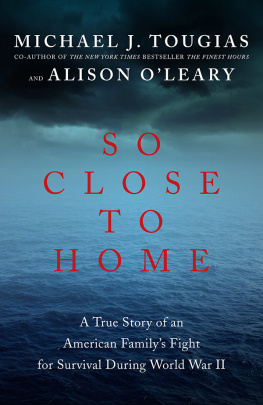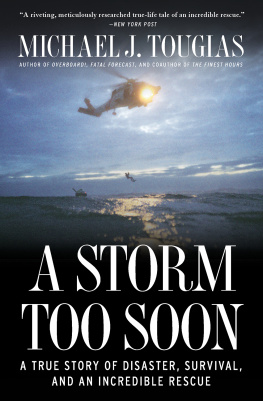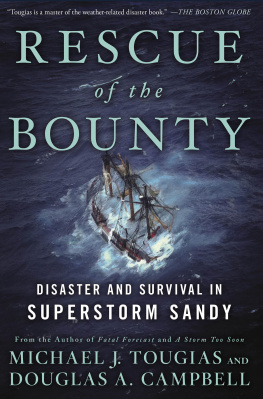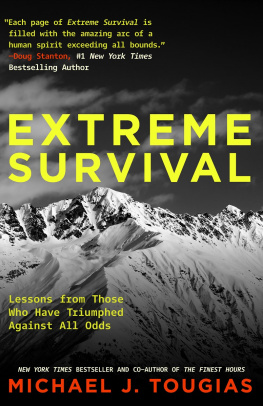
SO CLOSE
TO HOME
A TRUE STORY OF AN AMERICAN FAMILYS
FIGHT FOR SURVIVAL DURING WORLD WAR II
MICHAEL J. TOUGIAS
AND ALISON OLEARY

To the Downs Family:
Ray, Ina, Lucille, Terry, and Sonny
Contents
I n January 1942, a handful of German submarines, called U-boats (short for Unterseeboot ), cruised toward the American shores, ready to change the dynamics of the war that had been under way in Europe for over two years. They were instructed to take the war to North America, and that more U-boats would be following them to ramp up the attacks. The orders, written by Vice Admiral Karl Dnitz and approved by the Fhrer, gave the U-boat commanders considerable freedom to choose targets of opportunity rather than spend time locating a specific ship or even class of ship. Dnitz had a tonnage plan: sink Allied ships faster than they could be replaced, and sink them quick, before the American military implemented effective countermeasures on its home waters. Each U-boat would keep track of the approximate tonnage of the ships sunk so that Dnitz and Hitler could measure the success of the plan. Called Unternehmen Paukenschlag , or Operation Drumbeat, the mission would bring devastation to the doorstep of the U.S. now that America had entered World War II following the Japanese bombing of Pearl Harbor.
At first, the U-boat crews were subdued when their commanders explained the operation and informed them how little navigational intelligence they had about U.S. waters. The crews could not have guessed just how easy it would be to glide into American waters and achieve success beyond their wildest imagination.
The United States was ill prepared to defend itself against the U-boats, even though the Britishwho had cracked the German encryption code called Enigmagave ample warning that subs were headed straight to America. Instead of marshaling its defensive resources, the U.S. Navy had most of its limited resources employed in the Pacific and had done little to prepare for the U-boat onslaught. Many coastal cities ignored blackout requests, while navigational buoys and lighthouses still shone brightly, all of which helped the enemy enter shipping lanes and establish positions for spotting ships. American freighters and tankers traveled alone in coastal waters rather than in convoys with protection, and the ships usually remained lighted while frequently using their radios, which the Germans monitored. U-boat commanders could not believe their good fortune as they surfaced at night and saw the clear silhouette of a ship steaming by. Often, there were multiple targets to choose from, and commanders had to decide which one to home in on first. The success of the U-boats was so great just off the coast of the U.S. that the Nazi leaders referred to the next six months as the Second Happy Time, similar to successes the Germans had had against British shipping in the opening months of the war.
One U-boat captain adopted the strategy of waiting for prey near a navigational buoy and picking off ships as they passed by, rather than burning his valuable fuel searching for vessels. In New York, the Jacob Jones (DD130), the first destroyer assigned to anti-submarine patrol along the East Coast, was sent out to locate and bomb a particularly successful U-boat, only to become more fodder for the enemy. On the Jacob Jones second day of patrol, a U-boat torpedoed the destroyer, killing 138 sailors. Farther down the coast, in North Carolina, so much oil spilled from torpedoed tankers that several beaches had to be closed. In some instances, people on shore could actually see the tankers erupt into flames before the ocean swallowed the ships and their crews.
Approximately 170 ships were sunk off the eastern coast of North America and in the Caribbean in a period of just four months. Finally, in April 1942, the U.S. improved its aircraft surveillance of German subs while simultaneously experimenting with the convoy system. This change, however, was only employed along the East Coast, and Admiral Dnitz simply diverted some of his subs to Central America and the Gulf of Mexico where the happy hunting could continue.
Two U-boats, U-506 and U-507, were the first to head toward the Gulf. Commanding U-506 was Erich Wrdemann, a young and daring opponent who had shown considerable skill. Wrdemanns hunt would take him deep into the Gulf, just off the coast of New Orleans and toward a freighter, SS Heredia , which carried the Downs family of San Antonio, Texas. This is the story of that family, U-boat 506, and what happened when their paths intersected on a May night in 1942.
SO CLOSE
TO HOME
Some experts think that if Hitler had had fifty more U-boats in 1939, he probably would have won the war.
Wolfgang Frank, The Sea Wolves
E ight-year-old Raymond Sonny Downs, Jr. was disappointed by the drab grey freighter called Heredia looming above him at a port in Costa Rica. Sonny had steamed from the United States to South America eleven months earlier, and that ship had been a cruise liner with all the comforts of a five-star hotel. Now, on May 12, 1942, his return trip to the States would be aboard the Heredia , an old ship that was primarily transporting produce rather than pampered passengers. The big difference, however, between his earlier voyage and the one he was about to embark on was the risk. The United States had entered World War II five months earlier, and Germany had sent her U-boats toward the Americas for what they considered easy hunting.
Sonny was aware that war had broken out, but at this moment he was more intrigued with the giant cargo nets of bananas that were being loaded onto the Heredia . He and his eleven-year-old sister Betty Lucille, who preferred the name Lucille over Betty, ran up the gangplank to the ships deck for a better view of the stevedores working below. Lucille, brown-eyed with a dimpled chin and a full head taller than Sonny, didnt know there were this many bananas in all of Costa Rica and Colombia, where they had been living these last few months. Other workers were loading heavy sacks onto the ship, and Sonny, never shy, asked a senior crew member of the Heredia what was in them. Coffee, young man. All bound for the U.S.
We thought so, said Lucille, thought we could smell coffee.
Well, youre too young for coffee, but would you two like a Coke?
You bet! exclaimed Sonny.
Okay, follow me to the galley.
Lucille shouted down the gangplank to their parents, telling them they were going to the galley, and the two youngsters skipped away, Sonny barefoot. Maybe this trip is going to be a good one , thought Sonny. It doesnt matter how old the ship is if the crew is nice.
Sonny was correct: it wasnt every day that children were onboard the freighter, and the crew was more than accommodating. In fact, only ten of the sixty-two people aboard the ship were passengers; six were members of the Navy assigned to man the guns mounted on top of the bridge; and the rest were crew. And yes, the 4,700-ton Heredia had steamed many a mile since she was built thirty-four years earlier in 1908. Powered by an oil-burning engine that turned a massive propeller, the steel ship was 378 feet long and had a large funnel that belched black smoke from the spent fuel. Although the vessel was originally a passenger ship named the General Pershing , it had been converted to a freighter by the United Fruit and Steamship Company and renamed Heredia . Most of its former elegance had been worn away by time and rust, and now it was a tired old workhorse. But as Sonny and Lucille Downs bounded after the crewman toward the galley, they couldnt wait to get under way and explore every inch of the freighter before they expected to reach New Orleans in seven days.
Next page










